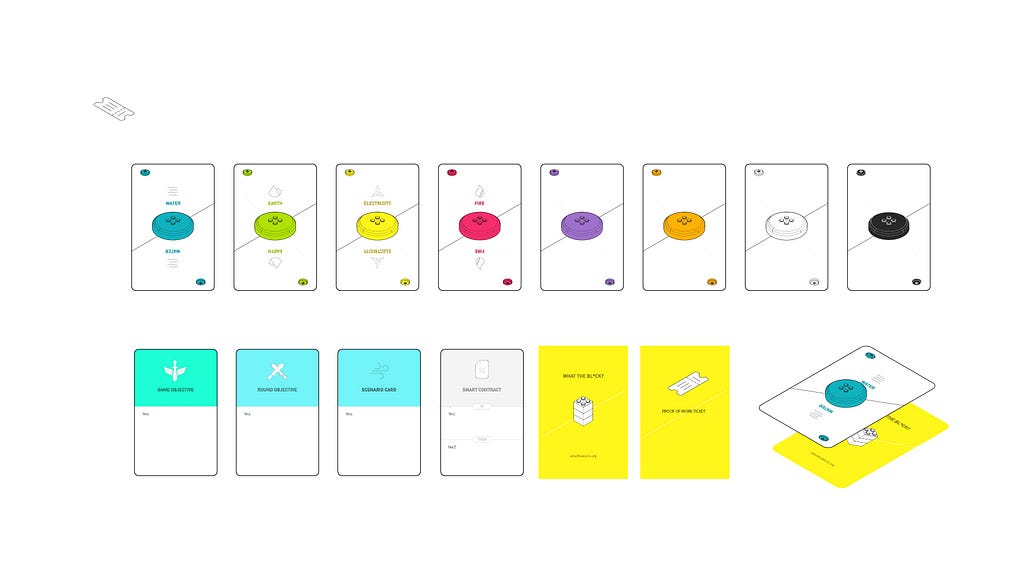Latest news about Bitcoin and all cryptocurrencies. Your daily crypto news habit.
What The Block is a project which aims to engage people through design to learn and discover the potential of new technologies. We started out with Blockchain, since designers working with Blockchain, we had been inundated with requests from colleagues, peers, clients, family and friends to explain it — the problem was we couldn’t find any good existing material out there.
So we decided to try and change this, by creating something that could make learning about Blockchain fun, accessible and hopefully inspire people to build interesting projects. We ended up designing a game, which has now been played by over a hundred people, and has been nominated for some awards, so we thought we’d share our story.
Origins of the Project
In 2017, John Ferreira and myself, like many other people riding a wave of crypto optimism, were launching a Blockchain product that was going to change the world. In the Blockchain space, our profiles was quite atypical. We weren’t hackers, mathematicians, software engineers, or ex-financiers, but designers. Few of our design peers understood what we were trying to do, almost none of them had any grasp of Blockchain, yet most of them were highly critical of it.
We became “The Blockchain people”, a target for others looking to regurgitate things they had skim read online. We were blamed for blockchain failing to reach the masses. We were scolded for Blockchain not living up to its potential. We were interrogated about the lack of everyday applications. And of course we were informed that it’s just for illicit activity (accompanied by accusatory glances).
More generally, it seemed that while we were growing more interested in the topic, others were growing more critical of Blockchain by the day, with increasing amounts of increasingly less passive animosity aimed squarely towards it. This is exemplified rather well by the fact that this largely ranty article about the failure of blockchain has now reached more than 50k claps here on Medium. My sarcastic response only received 1k.
While I’d love to say that this is a load of rubbish, the problem is that the evidence is against me. As 2018 began, we saw the crypto wave that swept us all up (ourselves included), crashing pretty hard upon the shore, ironically leaving anything apart from whales roundly beached. Amidst a million great ideas, the real, scalable products are few and far between. Most of the projects launched via ICOs that people were desperately trying to support, are now either dying, dead or evaporated into thin air. Indeed a lot of the intrigue, buzz and interest has now dissipated.
So one year ago, as Blockchain began to sink into the trough of disillusionment, at this most opportune of moments, we decided to create What The Block with the ambitious aim of trying to educate the masses about Blockchain, and inspire greater positivity around the technology, not by telling people what it is, but showing them what it can do.
This aim was born out of a collective dissatisfaction shared by John and I that extended across various themes:
- We were severely frustrated by the rubbish information for non-experts that was out there.
- We were constantly dismayed by the sorry state of design, usability and aesthetics in the blockchain industry.
- We were largely unimpressed by the lack of imagination and relentless focus on finance, supply-chains and identity (even if they are all important topics).
- We felt the apathy of non-blockchain, or more correctly non-crypto people, i.e. most people, to anything blockchain related.
- Mostly though, it was the number of times we had to try to explain to people what we were doing with our own blockchain projects.
While some people initially showed interest, overall the apathy and downright cynicism of non-blockchain (i.e. most) people, to anything blockchain related was what really got to us, given what the technology potentially offers.
So we decided to try and change that. We decided that we would like to start sharing our knowledge, using our skills as designers to have another look at Blockchain and see if we could do a better job explaining it, and its potential, than the other methods out there. With that in mind, we set an objective for 2018 to develop and teach a workshop about Blockchain for people of all backgrounds.
Our Process
Almost immediately the idea of developing a game sprung to mind, the logic being that games are fun, and people like fun. But how could we make learning about Blockchain fun?
We did some research to try and understand why learning about Blockchain was currently so painful. This led us to realise that the medium (mostly video), and the message (what Blockchain is) was frustrating people. They really wanted to know what it could be used for, but in the absence of clear use cases, this was difficult to grasp.
Since mass adoption of the technology is some way away, and there are few opportunities to really use it in everyday life, we decided to develop something that would quickly address the basics of what blockchain is, before moving on to the more difficult task of allowing people to explore what it could do. This requires a narrative, which games often employ to immerse people, to help them believe it is real. While our game was never going to be an epic tale, we needed to craft a story which offered a context and license for people to explore creatively.
Through our research we stumbled upon the work of Chris Speed and the Design Informatics Lab at Edinburgh University. They had created a Lego based workshop tool to explain Bitcoin. We looked at this and thought that we could build upon it, to design a fully-fledged game, and extend it to incorporate more of the core elements of Blockchain, such as Tokens, Mining and Smart Contracts. So we started prototyping.
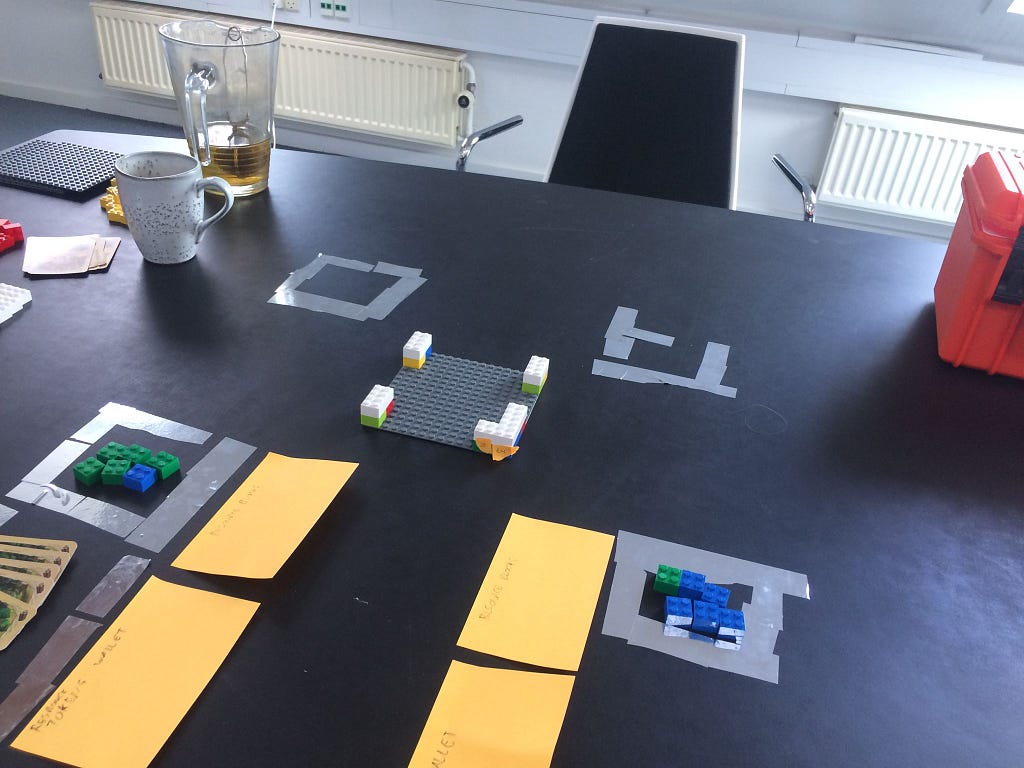 An early prototype of the game before we had shiny cards and fun people to play with
An early prototype of the game before we had shiny cards and fun people to play with
By prototyping and testing our ideas we quickly settled on a logical set of components for the game, and a structure for gameplay. However somehow it didn’t seem fun, and when we tested it with people it was obvious that there was something missing.
So for inspiration, we started to hang out at the local board game cafe to play games more often. They were indeed much more fun than our prototype, and while some of that came down to the subject matter, a lot of it came from basic game elements like rules, a clear structure, an objective and a winner. While we didn’t necessarily want people to win, giving people a clear objective, a reason to keep playing, was clearly important.
The Game
So we got to work designing a game which employed carefully written scenarios, specially designed cards, and Lego blocks to take people ‘from Zero to Blockchain hero’, over four rounds of play. What we settled on was a game that starts out as a simple trading game, evolving over the rounds, with participants gradually accumulating knowledge, which they can apply in later rounds.
Here is a shot of some of our cards:
The first four coloured cards represent resources which are traded in the game. The remaining four cards are ‘blank’ resources, used in later rounds to aid brainstorming. We created round, and overall game objective cards, scenario cards and a smart contract card that could be used to detail the rules of a smart contract.
The game itself is played using a board. The board becomes a hub of activity, a system where socio-economic interactions occur, rules and conditions are defined, and relationships are built, all recorded on a Lego Blockchain.
Our board ended up looking something like this:
 The game board from What The Bl*ck game
The game board from What The Bl*ck game
While Blockchain is a digital technology, our approach purposely involved using an analog game format, to create something tangible. From our research we understood that using physical objects helped people retain information better. Thus, each element in the game was carefully thought out and considered to help people build a mental and physical representation of core Blockchain elements such as Tokens, Blocks and Ledgers.
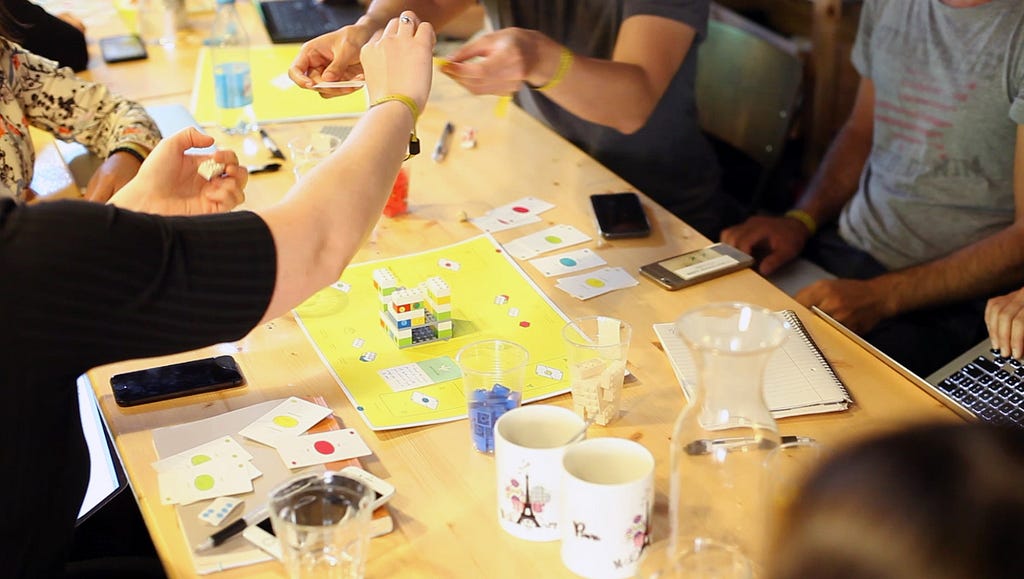 Participants playing the trading game at Techfestival 2018
Participants playing the trading game at Techfestival 2018
The game evolves over four rounds. Rounds one and two involve a simple trading game, during which participants learn about the most fundamental concepts and features of Blockchain. In round one gameplay is extremely simple, with the objective being to help participants get familiar with the rules and format of the game. Even at this early stage they begin to learn some of the basic features of a Blockchain such as blocks, a ledger and cryptographic tokens.
In round two, the teams are introduced to more complex ideas, such as decentralization, mining, and double spending. In addition to the main game, they play an online game that we coded up to simulate the epic battle that occurs between machines to obtain new value, also known as Proof-of-Work mining. The winners of the mining game get to open a magic chest, which similarly to the mining in a Blockchain world, offers new value in the form of tokens.
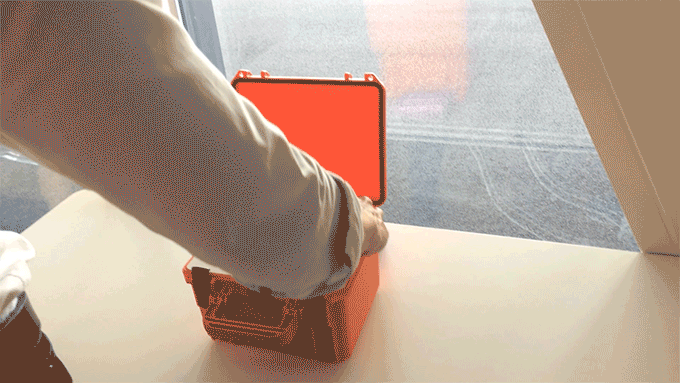 A winning miner opening the magic mining box (on loan from colleagues at CIID)
A winning miner opening the magic mining box (on loan from colleagues at CIID)
In round three, we use the accumulated knowledge of the first rounds to develop new concepts for value, a very difficult concept, and far more difficult to understand than how a Blockchain works. Each team brainstorms to come up with an interesting new concept, packaging it within a Token, before attempting to trade it with other teams. As the round evolves, teams are able to iterate and build upon their ideas.
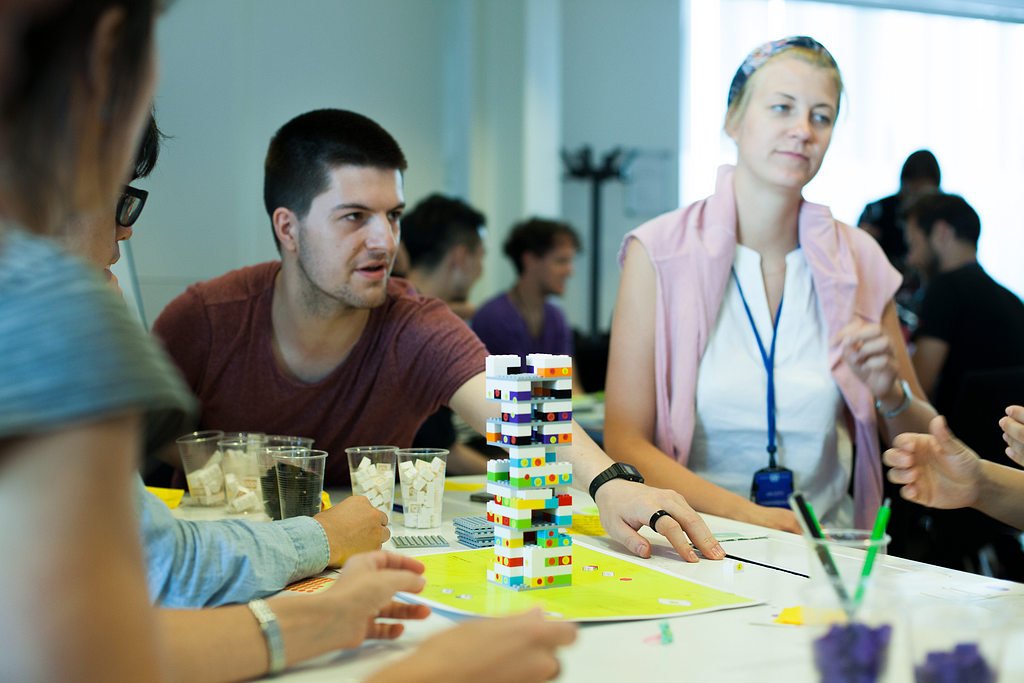 Participants learn by doing, building mental and physical representations of Blockchain concepts.
Participants learn by doing, building mental and physical representations of Blockchain concepts.
In round four, we bring governance into play through the use of smart contracts. Using our smart contract cards, the teams seek to create rules which apply to the overall economic system that is now in full flow. This marks the climax of the game, with teams trading new concepts of tokenized value, governed by smart contracts all recorded on a public ledger.
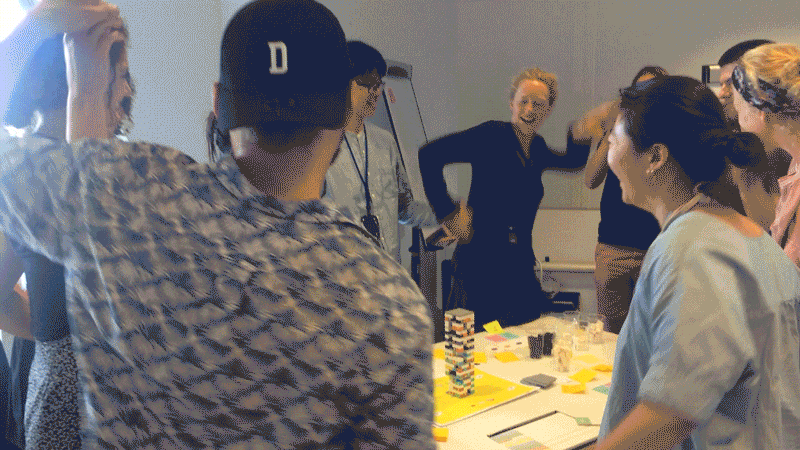 This is what a smart contract looks like
This is what a smart contract looks like
Through the game, we inspire curiosity and allow people to learn without any prerequisite knowledge, in a fun and fast-paced manner. We do this through a technique known as top-down learning — immersing participants in the world of Blockchain, building their knowledge, and allowing them to start asking relevant and insightful questions. This usually evolves into a group discussion facilitated by us, using tools like slides, stories and examples to reinforce knowledge and develop a precise technical vocabulary.
Does the Game Work?
To date, we have used the game in our ‘Designing with Blockchain’ workshops, which range from half a day, to five day sessions. In longer sessions we run a full design workshop, in order to help people come up with robust concepts which employ the features of Blockchain — facilitating value transfer, in transparent systems, where trust is a feature.
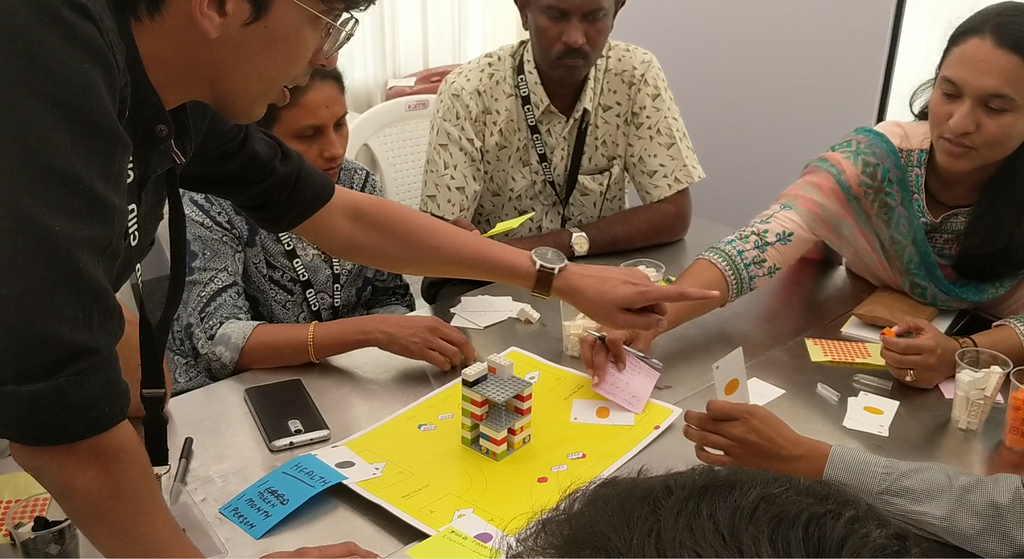 We’ve taken the game from Copenhagen to Kochi
We’ve taken the game from Copenhagen to Kochi
Thus far we have had more than 100 people play the game, held workshops from Copenhagen to Kochi, and the feedback has been great. We’ve had computer science graduates tell us that it has helped them make sense of Blockchain. We have inspired a commerce professor to go down the Blockchain rabbit hole. In general the game has proven to be a great equalizer, making the technology and its potential accessible to a wide audience.
We’ve heard from many people that they’d struggled for months trying to grasp even the basics of Blockchain, but by playing our game, in just a few hours they not only could understand what Blockchain is, but could begin to craft their own concepts. We’re especially proud of the feedback we’ve received from participants who work within the philanthropic, NGO and public sector, who have told us that our approach has helped them uncover a world of new opportunities.
What’s Next
We have had an amazing response to the game, been nominated for some awards, and have been inundated with requests to run workshops (and we’re always happy to receive more).
As we are currently a team of two, it is proving to be quite difficult to run enough workshops, so this year, we will be developing a stand-alone game that could be used in organizations, classrooms, and even at home. Coming to your favourite crowd-funding site soon!
What’s been most satisfying is that our approach to making education fun, and creating a new way of engaging with Blockchain, seems to have struck a chord. While this article has focused largely on the game, we will be publishing a further article explaining our take on Blockchain and some of the outcomes of our Designing with Blockchain workshops in the coming weeks.
Cyrus Clarke and John Ferreira are co-founders of What The Block, Making Blockchain More Human. We are alumni of The Copenhagen Institute of Interaction Design with whom we will be running workshops later this year. (sign-up!)
We’d love to hear what you think, so do reply with any questions and comments you might have. And of course feel free to get in touch with us here
What the Bl*ck is Blockchain? was originally published in Hacker Noon on Medium, where people are continuing the conversation by highlighting and responding to this story.
Disclaimer
The views and opinions expressed in this article are solely those of the authors and do not reflect the views of Bitcoin Insider. Every investment and trading move involves risk - this is especially true for cryptocurrencies given their volatility. We strongly advise our readers to conduct their own research when making a decision.
